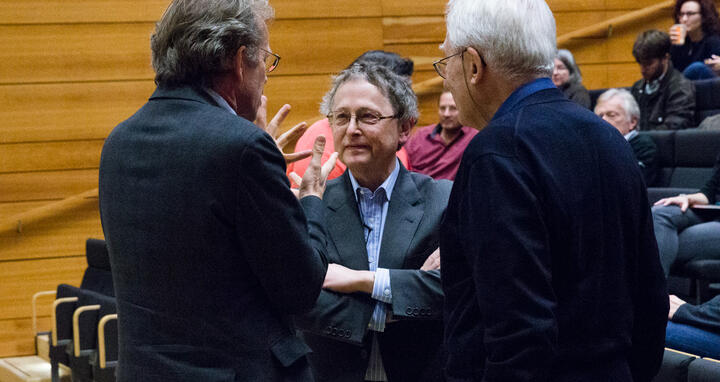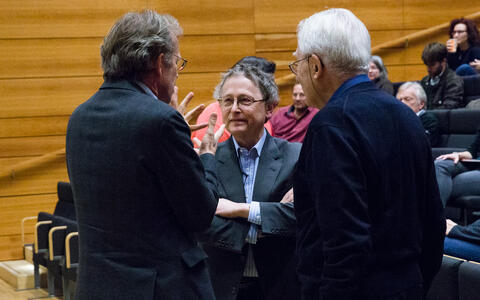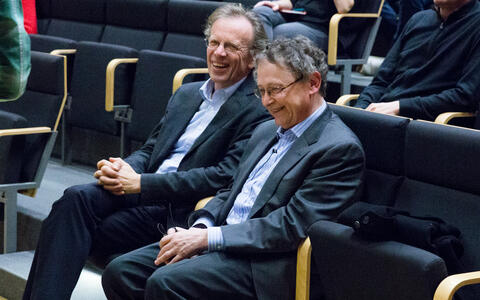The quest for an HIV vaccine
Michel C. Nussenzweig of The Rockefeller University held the third MDC Lecture in Berlin on November 3, 2016. Entitled “The HIV Problem”, the lecture included details of his previous findings and developments in the search for effective drugs against the human immunodeficiency virus (HIV).
The HIV epidemic of the 1980s spread fear and anxiety all around the world. Anyone who contracted the virus and went on to develop acquired immunodeficiency syndrome (AIDS) was likely to die a terrible death within a short space of time. Today, the symptoms of AIDS are readily treatable. However, the disease is not yet curable and it cannot be prevented as the structure of the virus is too variable. According to the United Nations Programme on HIV/AIDS (UNAIDS), more than one million people worldwide still die of AIDS every year. Almost 37 million people are currently living with HIV, with another 2.1 million newly contracting the virus every year. These figures show that the spread of the disease has been restrained but the fight is far from over, even if 17 million patients now have access to antiretroviral therapy.
Nussenzweig as guest speaker at the MDC
An effective vaccine would be a dream come true – and Michel C. Nussenzweig has made significant headway in achieving this goal. The researcher, who holds a Cohn-Steinman Professorship at The Rockefeller University in New York, was in Berlin for two reasons: to present his work in the third MDC Lecture and to accept the Robert Koch Prize the next day, which he was awarded in recognition of his findings in the fight against HIV. Klaus Rajewsky, the researcher’s host for the day, told the audience at the MDC.C about this award and provided a brief overview of the scientist’s career: the “Rockefeller man”, as Rajewsky put it, obtained his PhD at the renowned New York university. After working as a postdoctoral researcher at Harvard Medical School, Nussenzweig returned to Rockefeller in 1990. He has been at the university ever since and is now head of the Laboratory of Molecular Immunology.
Antibodies against HIV
Nussenzweig focuses on molecular aspects of the immune system, specializing in B lymphocytes and HIV-1 antibodies. His research has led to the development of innovative new vaccines against pathogens and new treatment methods for autoimmune diseases. “His most spectacular achievement is his work on antibodies from which medical therapies can now be derived,” said Rajewsky in his opening speech. Antibodies are the most powerful weapons of our immune system. They protect us from a variety of pathogens by recognizing proteins on their surface as “foreign” and binding to them, neutralizing the pathogens. This, however, does not work with HIV as the virus changes its shape so quickly that antibodies stop recognizing it as a foreign invader. Nussenzweig explains that antibodies capable of disabling a number of HIV variants were discovered some time ago, but they only work in very high doses and the chances of recovery are slim – which is why they were not extensively researched for a long time.
Surprising success in a previously neglected area of research
A few years ago, Nussenzweig breathed new life into this area of research. He explained how certain antibodies can adapt through an unusually high number of radical mutations and render even HIV harmless. Some people, he says, develop effective antibodies against the virus and a tolerance to it: “This happens in about five to ten percent of all HIV patients.” In a bid to solve this mystery, Nussenzweig and his team cloned the genes of the highly effective antibodies and discovered something unusual: the antibodies are formed through successive cycles of antibody mutation, selection and virus escape. This process produces broadly neutralizing antibodies capable of making 95 percent of all HIV variants harmless. To create an effective vaccine, scientists would therefore have to trigger the formation of these rare antibody mutations, e.g. through repeated immunization against the different variants of the virus. Nussenzweig and his team have been able to achieve this – but only in genetically modified mice. “Iterative, sequential immunization is the way to go, but not an easy nut to crack,” he said in Berlin.
Cloned antibodies have direct therapeutic benefits
“Parallel to this, we also tried to use the antibodies directly in human therapies,” says Nussenzweig. His team investigated whether a one-off injection of the special antibody served a protective function in HIV patients when they stop taking their antiretroviral drugs. The study showed that antibodies are a safe and effective method for preventing and treating HIV-1 in humans – a groundbreaking result. The patients tolerated the single dose of antibodies well, their viral load was quickly reduced – and the effects were apparent for a period of several weeks. The infusions also triggered an endogenous immune response in patients, thereby accelerating the healing process against the virus and other infected cells. One type of antibody alone cannot, however, reduce the viral load safely and durably. For this reason, future antibody preparations are likely to consist of a combination of various highly potent antibodies administered in repeated doses.
The future of HIV therapy
Michel C. Nussenzweig and his team are currently investigating how antibodies can most effectively get past the large molecules of branched sugar chains surrounding the virus. The scientist wound up his lecture by saying that even though there is still a long way to go, he is convinced that the long-neglected antibodies have great potential for human treatment: “I think antibodies will be used for HIV prevention.”








